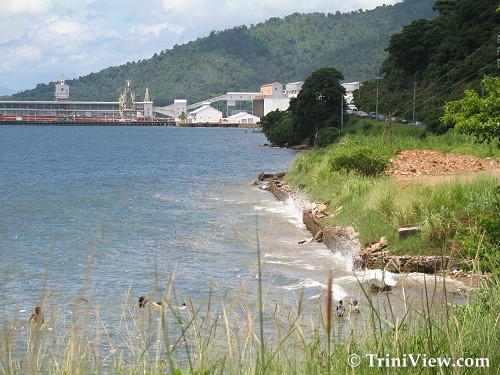 View from Western Main Road, Carenage
View from Western Main Road, Carenage
TriniView.com Reporters
October 24, 2006
Carenage, formerly known as Le Carenage, is one of the most popular bays located in west Trinidad. This bay, which is a famous sea bathing and liming area, got its name out of the practice of "careening", or cleaning out the waste materials in sea vessels, which was carried out in the area for centuries.
Initially, Le Carenage was the name given to the river flowing into this bay as well as the valley were the river flowed.
The Carenage valley, possibly because of its extremely fertile soils was essentially an agricultural area where crops sugar-cane, cotton and coffee were grown. In fact, the area contained ten sugar mills, five rum distilleries and a workforce consisting of 607 enslaved Africans and 131 'free' people of colour. Owners of the estates comprised of 19 families (64 whites), including the Dumas, Noel, Dert, Mercie families.
In 1849, Lord Harris made the Carenage area into district into a ward. Also, a few years later in 1851, an inland postal service was inaugurated in Trinidad, making Carenage one of the first places to receive mail in the country. Carenage was also one of first areas to set up primary schools in the country.
Despite the area's popularity as a fairly prosperous agricultural region, the face of Carenage seemed to change by the 1870's becoming a poor fishing village, although many were still involved in agriculture. It was at this time that parish priest (or abbé) Antoine Poujade came to assist the poor and helped to erect a chapel and a statue of St. Peter overlooking what is now known as St. Peter's Bay.
In 1941, the population of Carenage grew to about 2,000 and also welcomed new arrivals -- the American Soldiers who used the nearby village of Chaguaramas as a naval base. Due to the American presence, many Clubs and bars became prominent features of the village and became and economic boomtown during that period. Also, concomitant with the presence of the Americans were limited infrastructural changes such as electricity and pipe borne water, which were, at the time, for the comfort of the soldiers and not for the villagers.
Several years after the Americans left in 1962, the year of Trinidad and Tobago's independence, the Trinidad and Tobago Regiment occupied the old American army barracks in Carenage.
A year later in 1963, a 'reign of terror' occurred after a dispute between a soldier and a villager erupted and the villagers who became involved in the affair were victims of violence unleashed by the soldiers. This was a significant, though arguably, unfortunate event that took place in the country.
In 1971, the famous St Peter's Church was rebuilt after the original structure (abandoned and unused) was shaken and damaged by an earthquake.
Today, Carenage can be described as a small-scale fishing village, although most of its residents seek employment outside of the area. Carenage is still an extremely popular area and is a destination that families journey to for rest and relaxation.
Carenage and Chaguaramas in pictures:
www.triniview.com/gallery/main.php?g2_itemId=89353
Carenage and Chaguaramas | Homepage | Photo Gallery
|
